Report

At a Glance
- Over the past decade, most conglomerates in Southeast Asia underperformed pure plays in total shareholder returns, revenue growth, margins, and multiples.
- Compared to pure plays, conglomerates struggled to navigate lower-growth environments and market volatility.
- To defy the odds, conglomerates need to use technology to drive top- and bottom-line excellence in their core business units.
- They also need to rebalance their portfolios, streamline their corporate centers, and review their ownership structures to maximize value.
The end of the Southeast Asia anomaly
We started tracking Southeast Asia’s conglomerates in 2003 because they were an anomaly. They outperformed conglomerates in other parts of the world and outperformed pure play companies in Southeast Asia on multiple criteria, most notably annualized total shareholder returns (TSR). Between 2003 and 2012, Southeast Asia conglomerates’ average annualized TSR was eight percentage points higher than that of the region’s pure plays.
During those years, conglomerates had several advantages over pure plays: size, diversification, and close government contacts. Those factors were unnatural advantages. In more developed markets, it was more beneficial for companies to have a strong focus and leadership within a single industry. But in Southeast Asia, conglomerates that were spread across diverse industries defied conventional business wisdom and thrived.
Over time, however, conglomerates’ advantage eroded. As of our last report (published in 2020), the conglomerate advantage had dwindled. Today, it’s more akin to a liability.
For the first time in our analysis, pure plays significantly outperformed conglomerates in Southeast Asia. From 2013 to 2022, pure plays’ average annualized TSR was 11%—7 percentage points higher than that of conglomerates (see Figure 1). Pure plays outperformed conglomerates on revenue growth, margins, and multiples.
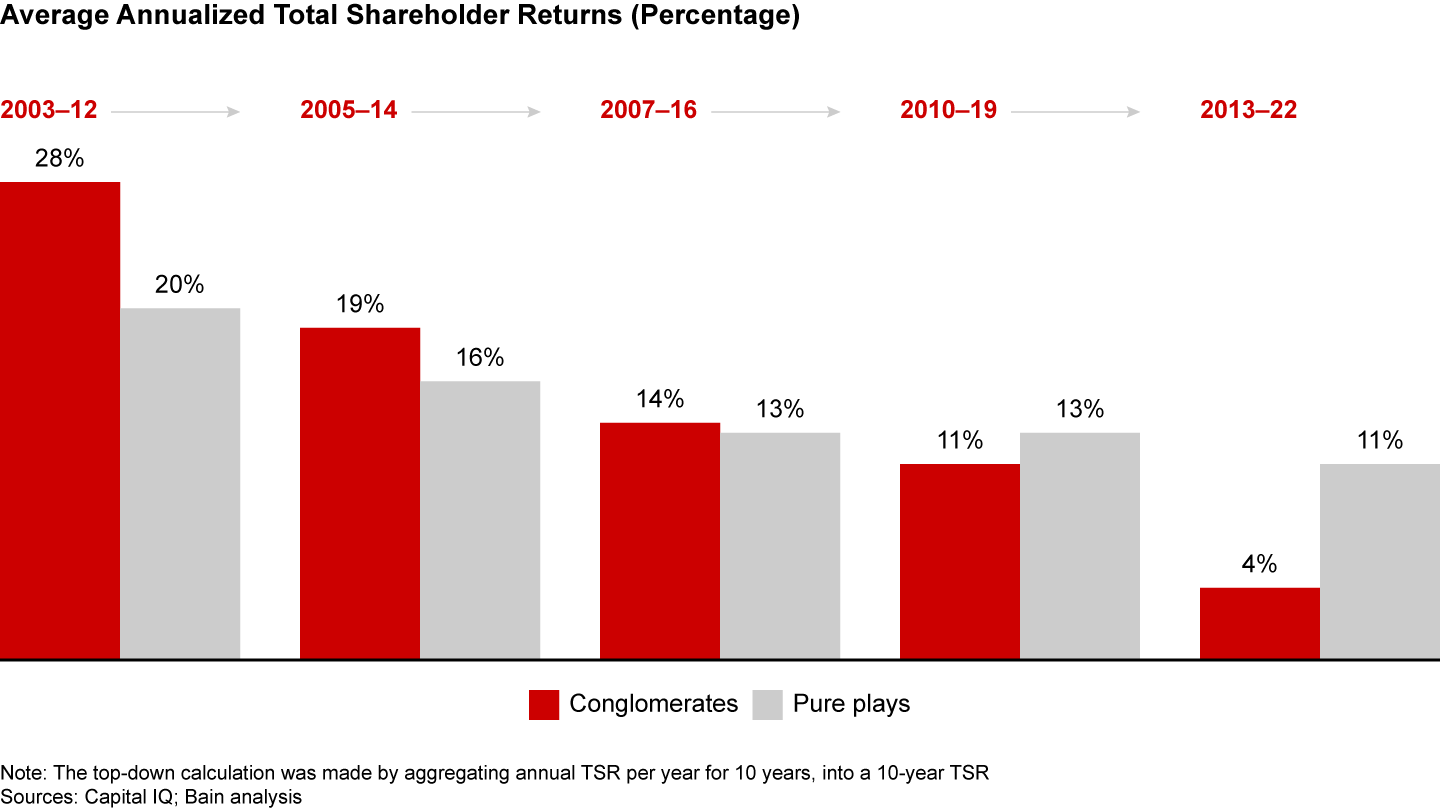

Over the decades, conglomerates’ performance weakened, and they lost their edge. Their TSR dropped 24 percentage points since our first analysis period (2003 to 2012).
Even the top-performing conglomerates struggled over the last decade compared to pure plays. The top quartile of conglomerates earned 14% TSR compared to 30% TSR for the top quartile of pure plays. And that trend continued along the quartile continuum. In the top three performance tiers, pure plays achieved double (or more) TSR than conglomerates (see Figure 2).
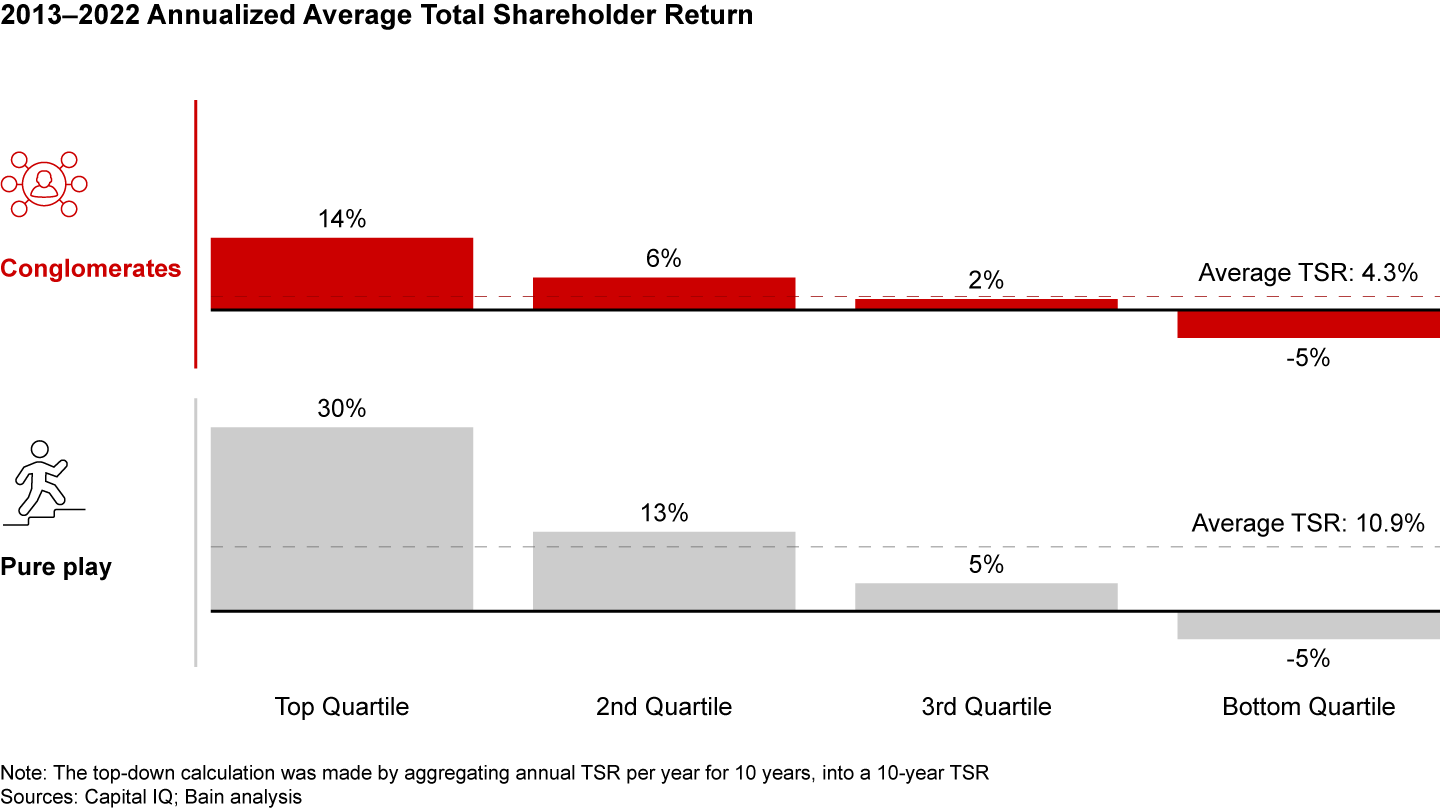

Shrinking returns matter—and not only to shareholders. While conglomerates’ share of regional economies has shrunk over time, they remain a major economic driver in the region, accounting for 17% of the market cap and 30% of capital expenditure. Southeast Asia needs its conglomerates to grow and create value.
What happened to conglomerates in Southeast Asia?
Pure plays started to surpass conglomerates in the middle of the last decade, and the performance gap has widened ever since. The long-term trend was accelerated by macroeconomic slowdowns across Southeast Asia’s economies, followed more recently by the Covid-19-induced crisis.
When the region was less developed, it was easier for conglomerates to prosper, thanks to their size and privileged access to opportunities, capital, and talent. In fact, conglomerates were often the preferred entry point into the Southeast Asia market for international investors.
As the region developed and its markets matured, conglomerates’ size, stability, relationships, and diversification ceased to give them advantages over pure plays. Young and nimble pure play companies were able to attract investors, government support, and talent by developing strong leadership positions in attractive sectors. Their efforts were focused and relentless—and paid off.
The conglomerate premium eroded first and fastest in developed markets such as Singapore, Malaysia, and Thailand, confirming a correlation between market maturity and conglomerate performance (see Figure 3).


This erosion was compounded by changes in the market. Starting around 2014, revenue growth shrank considerably across the region in response to global macroeconomic conditions. All companies had to work harder to create value, and conglomerates struggled to adapt to the lower-growth environment. They were slower to expand margins or exercise cost discipline to offset revenue losses, and their price-earning multiples contracted. In contrast, pure plays operated more efficiently and maintained TSR during the slowdown.
Finally, Covid-19 erupted. Most conglomerates hadn’t recovered from the slowdown when the pandemic sent new shockwaves of volatility across the economy in 2020. Conditions went from bad to worse, and many conglomerates didn’t have the right combinations of speed, agility, and efficiency to thrive through the crisis.
A shakeup among the stars
On average, conglomerate performance slipped. But not all conglomerates struggled.
Over the past 20 years, a subset of 12 conglomerates consistently outperformed their peers and achieved top-quartile status for TSR growth across all economic cycles—this period included. We call them “all-weather stars,” and they include companies such as Sinar Mas and Kalbe in Indonesia, BDMS Group and DKSH Holding in Thailand, Sunway Group and Hong Leong Group in Malaysia, and Enrique Razon Group in the Philippines. Even in lower-growth environments, these conglomerates increased revenue, defended their margins, and expanded multiples (see Figure 4).
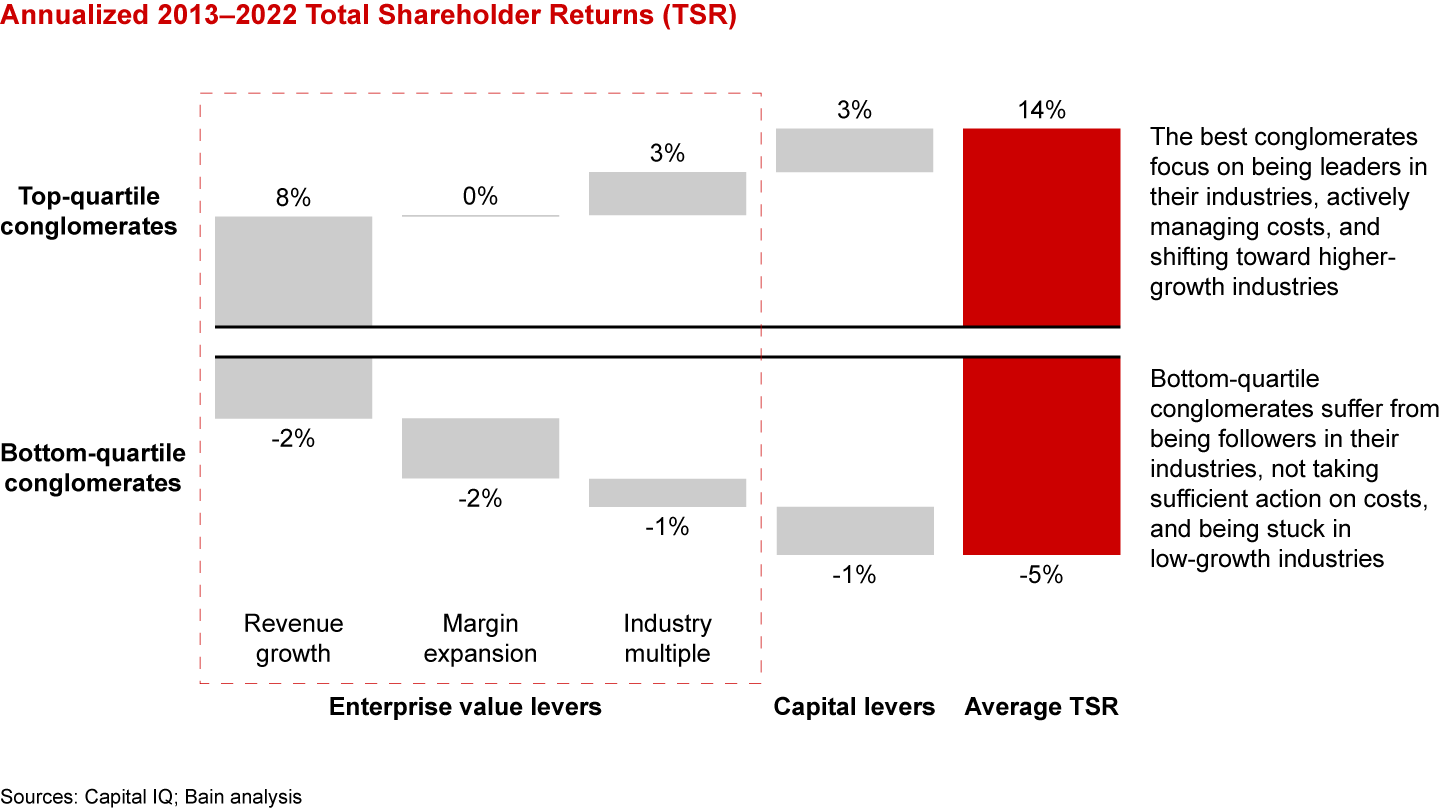

Only five all-weather stars were unseated by the conditions caused by the pandemic. Like many conglomerates in this study, they failed to adapt to challenging circumstances. Some were caught in the “wrong business at the wrong time” when the pandemic and movement restrictions dramatically altered demand. Others reacted to the crisis too slowly.
Interestingly, seven new all-weather stars rose into the top quartile of TSR performance. New stars such as PHINMA Corporation in the Philippines, Emtek in Indonesia, and VinGroup in Vietnam have businesses in essential sectors, such as healthcare and technology, and high-growth engines such as renewable energy.
How to defy the odds
We examined the tenured all-weather stars and the newcomers to compile five imperatives for conglomerates in Southeast Asia. The first three of the observations are evergreen truths, and the balance are newly observed phenomena. Together, they can help conglomerates defy the odds, regenerate value, and revive performance through the cycles.
Conglomerates in Southeast Asia must:
1. Strive for strategic and operational excellence in their core business units
All-weather stars continually reinvest in their core businesses to manage their strategic positions and offset erosion of the conglomerate advantage. And they pursue leadership within their industries. In our study, 44% of top-quartile companies are leaders in their primary business, compared to only 16% of companies in the bottom quartile.
All-weather stars manage operational performance better too. For instance, ~80% of top-quartile performers reduced their operational expenses as a percentage of revenue during the last decade (2013 to 2022). Only ~40% of bottom-quartile conglomerates lowered expenses.
Consider Enrique Razon Group, a leading Philippines conglomerate. It automated workflows at ports and established a centralized and integrated digital platform. As a result, productivity and operations improved and EBITDA margins increased from 47% to 53% between 2016 and 2022. In 2022, EBITDA increased 24% over the previous year, which Chairman Enrique Razon attributed, in part, to tight operational controls.
“In a year marked by geopolitical unrest and inflationary pressures, we took clear and robust actions to focus on our cost initiatives and implemented a selective and disciplined capex program, which has pleasingly created value for our stakeholders,” Razon said.
2. Dynamically reshape portfolios to succeed in a volatile world
The top quartile of conglomerates actively reshaped their portfolios toward high-growth industries and growth engines of the future. They also engaged in more merger and acquisition (M&A) activity and reshaped their portfolios better than peers.
Between 2013 and 2022, the top quartile of conglomerates was more active in M&A than the bottom quartile. During downturns, M&A activity slowed across the board. But the top quartile cut M&A by only 18% between 2020 and 2022, compared to a 45% reduction among bottom-quartile companies.
Portfolios are also balanced differently between the top and bottom quartiles. In top-quartile companies, about 35% of market cap is driven by high-growth sectors, compared to only 5% for the bottom quartile (see Figure 5). Bottom-quartile companies tend to be stuck in lower-growth industries, whereas leaders actively rebalance their portfolios through investments, divestitures, and strategic alliances.
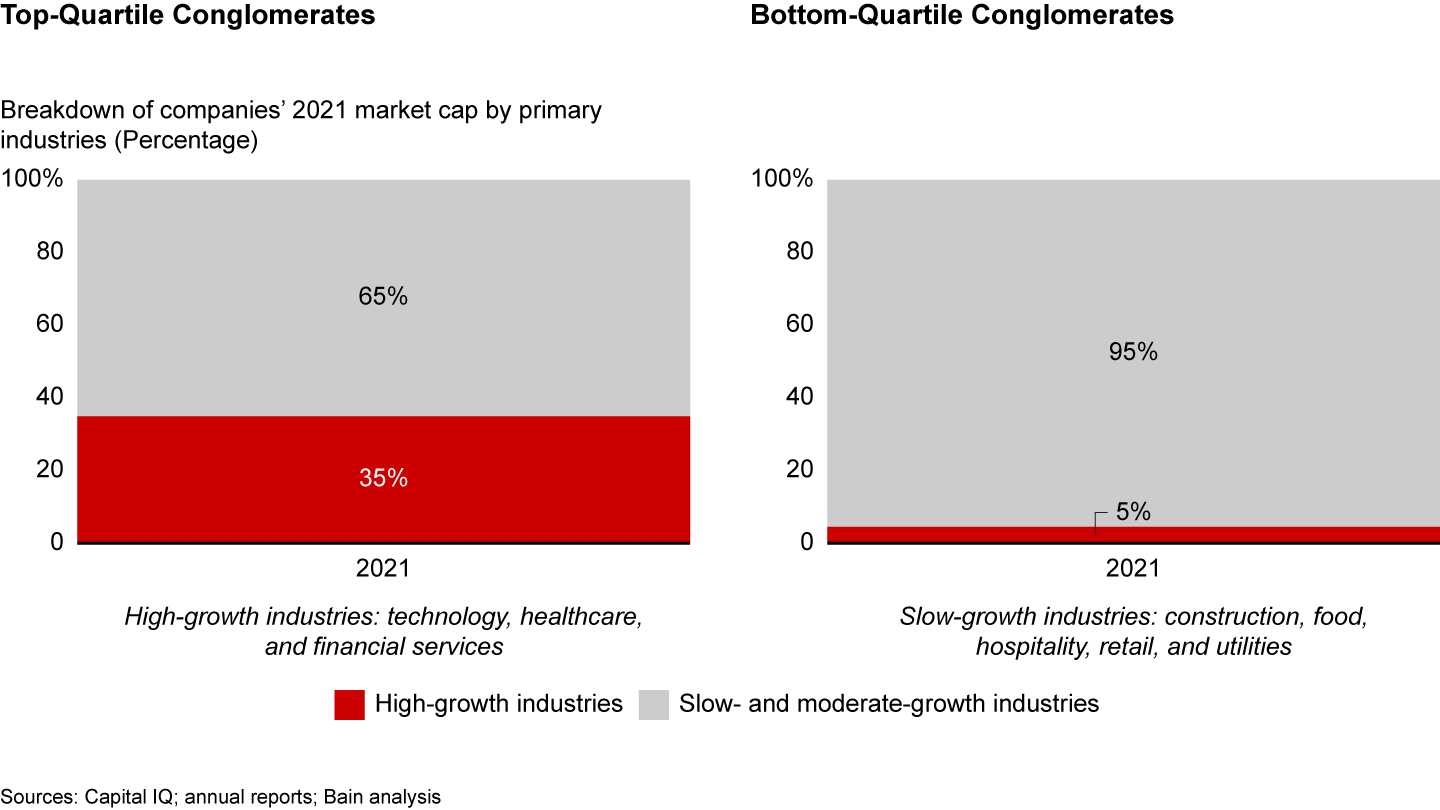

Consider the Indonesian group Emtek, one of the rising stars. In 2013, about three-quarters of Emtek’s revenue came from traditional media. In 2015, it started trading some of its media business for higher-growth prospects in technology, healthcare, and life sciences. Now, media accounts for only 46% of Emtek’s revenue, and the balance comes from higher-growth industries. By shifting its portfolio, Emtek increased TSR 11% between 2013 and 2022 and nearly tripled its multiple.
Where are the next high-growth opportunities? Several sectors—such as healthcare and renewable energy—are poised for growth. Demand for healthcare has remained high since the pandemic, plus there’s ample room for technology-driven business models and innovation in the market. Interest in “green energy” is steadily rising too. Energy transition and decarbonization opportunities have strong momentum and material upsides for companies in the region.
Top conglomerates are already making strong plays and impressive progress in these sectors. Sunway Group, a diversified Malaysian conglomerate, significantly increased its participation in healthcare, which jumped from less than 5% of the company’s revenue in 2013 to 17% in 2022. When Sunway realized its hospitals were more efficient than those of competitors, it aggressively expanded its hospital business. In the near term, Sunway expects 50% to 60% of its expansion to come from healthcare. Eventually, leaders said, Sunway’s healthcare business may become bigger than the group.
In Indonesia, new green-minded business lines contributed to soaring growth for Adaro Energy. It shifted some of its attention away from coal mining and toward mineral mining and aluminum smelting to support new demands for the green economy. Annualized TSR increased 15% between 2013 and 2022.
PHINMA Corporation in the Philippines is another rising star, with 26% TSR growth during the pandemic period (2019 to 2022). It thrived during Covid-19 by focusing on tertiary education for lower-income households in the Philippines. Since then, it has successfully replicated its distinctive model across the region.
As the leaders demonstrate, conglomerates can thrive in extreme and challenging circumstances by dynamically reshaping their portfolios.
3. Redefine the corporate center’s role and how it distinctly adds value
For the last decade, Southeast Asian conglomerates have struggled to define the role of the corporate center. Many conglomerates bulked up their corporate centers and created group functions for procurement, information technology, and commercial excellence to drive value and pursue portfolio wide synergies. But the attempts often failed. Strong business units did their best to avoid what they perceived as corporate interference. In weaker businesses, support from the center didn’t fundamentally change their competitive disadvantages. However, additional costs incurred by central groups had a significant impact on group results.
It is possible to add value from the center, however. There are two successful, albeit very different, approaches.
The first approach is more “hands on,” where the corporate center adds value to each business so the value of the group becomes greater than the sum of its parts. The best corporate centers “pick their battles” and develop distinct capabilities to support their portfolio companies.
On the other end of the continuum, the center acts solely as an investment manager. No synergies are sought or extracted from the businesses, because each company is independently strong and has sufficient scale and capabilities to compete on its own. The center stays narrowly focused. It oversees buy/hold/sell decisions, puts high-quality management teams in place, and fosters the right performance dialogue with each business unit. For this approach to work, conglomerates need small, disciplined, and highly skilled staff at the center.
Most Southeast Asia conglomerates operate (or find themselves stuck) somewhere in the middle. Instead of adding value from the center, they increase overhead. Looking globally, however, there are standout examples of each approach: American conglomerates Danaher Corporation and Illinois Tool Works (ITW) both add value from the center, while Investor AB in Sweden and Jacobs Holding in Switzerland expertly manage their conglomerate portfolios.
Danaher is one of the world’s top-performing conglomerates, with TSR of 17% between 2003 and 2022. Over time, it reshaped its portfolio away from industrial companies and into a set of life science and diagnostics-focused businesses. At Danaher, the power of a cohesive portfolio is supported by a conglomerate-wide toolkit and mindset. It maximizes efficiency and drives value by applying a uniform operations model—the Danaher Business System—in each of its business units.
The Danaher Business System is both a tactical toolkit and a cultural mindset. “It’s in our DNA,” a Danaher employee said. “Kaizen is a ‘way of life,’ and the Danaher Business System fosters an intense focus on identifying and solving problems.”
Similarly, ITW manages a tightly knit set of industrial businesses with the ITW Business Model, a set of strategic, operational, and cultural practices. ITW empowers its business unit leaders (who are closer to customers) to make decisions about staffing and capital investments.
ITW’s corporate center is kept intentionally lean (less than 80 full-time employees). Its role is to allocate capital and talent, plus common tools and methodologies, to maximize performance.
“If a business is not generating segment returns or selling well, then it’s placed in an austerity program and unable to hire or re-invest unless there’s a dire need,” a former vice president and general manager from ITW explained.
Investor AB of Sweden takes a different tack; it uses the investment management approach. Investor AB is an industrial holding company with significant stakes in ABB, AstraZeneca, SEB, and the private equity firm EQT Partners, among others. It has a long and distinguished performance record—including a 13% annualized TSR increase between 2003 and 2022. Its center actively manages investments and divestments, appoints the boards and CEOs, and leverages its deep talent pool. It also maintains rigorous dialogue about results with portfolio companies.
Privately held Jacobs Holding of Switzerland is another example of this approach. It uses majority investments to shape its portfolio, shifting away from the family’s original core industries (coffee, cocoa, and confectionary) into healthcare and education. Jacobs takes a long-term view to build and nurture global market leaders such as Barry Callebaut and the Adecco Group, and more recently, Cognita Schools, Colosseum Dental Group, and North American Dental Group.
Over many years, Investor AB and Jacobs have refined the active investment manager approach and built capabilities on par with leading private equity firms. As multigenerational firms, they have the advantage of taking a longer-term view, and they’re not forced to exit investments to provide returns to limited partners. As such, this is a viable model for family-run businesses that aspire to thrive for multiple generations.
Back in Southeast Asia, top conglomerates are actively trying to shape an ideal center. Sime Darby’s center shrank from a staff of 500 to less than 150 over the last few years. It also decentralized and streamlined decision-making so most operational decisions can happen at the business level, fostering efficiency.
Sunway Group’s center is focused on empowerment. It coordinates and offers some shared services across the portfolio and decides how to invest surplus funds. But one of its biggest contributions is finding, developing, and empowering leaders with the right business acumen.
4. Invest heavily in innovation and technology
The top conglomerates invest heavily in technology—and have for years. They’ve become experts at using data analytics and automation to maximize top- and bottom-line productivity. Now, they are also leveraging technology to command a premium, shape new products and services, and generate new revenue streams. In some cases, top conglomerates can even monetize their data and their proprietary data platform services.
Technology helped Indonesian family conglomerate Sinar Mas optimize productivity across its agricultural practices and maintain cost leadership. EBITDA margins doubled, growing from 12% to 24%, between 2014 and 2022. Sinar Mas implemented advanced information technology systems to achieve “digital precision” in its agriculture practices. Robust data collection drives accurate and timely decision making for the company, which leads to higher-quality plantings and higher yields.
Aboitiz Equity Ventures in the Philippines is banking on data science and artificial intelligence (DSAI) to command what it calls a “techglomerate premium.” Through its subsidiary Aboitiz Data Innovation, Aboitiz uses DSAI to enhance operational efficiency and improve decision making across its portfolio. Examples include an AI-powered credit scoring and risk management tool for its banking arm, UnionBank, as well as AI-driven algorithms to predict kilowatt-hour prices for its primary business, Aboitiz Power. The group plans to expand these services externally for financial services, power, and smart cities players in Southeast Asia.
In Thailand, CP Group set up True Analytics to capitalize on one of Thailand’s largest customer databases. It uses analytics to drive operational efficiencies and top-line focused-use cases for CP Group companies and the external market. Its analytics services support advertising and customer acquisition, customer intelligence and segmentation, a customer data platform, credit risk evaluations, and location insights.
Generative AI is nascent but has the potential to turbocharge innovation and push companies to new levels of productivity and customer engagement. Conglomerates should invest in high-impact use cases, rather than casting a wide net of possible applications. CP Group, for instance, will prioritize software development, customer service, and personalized advertising. Promising use cases can be piloted within subsidiary companies, then rapidly expanded.
Technology strategies need to be well resourced. Winning with innovation requires infrastructure, advanced tools, top talent, and strategic partnerships. Conglomerates will need deep data and platform skills, which they may not currently have in-house.
5. Optimize capital structures to reduce the conglomerate discount
In the past, conglomerates used capital markets to raise money and de-risk capital-intensive businesses. Over time, some conglomerates became an unwieldy mix of publicly listed and privately held subsidiaries.
Ownership and capital structure impact a conglomerate’s value in the public market. As Southeast Asia’s economies and capital markets have matured, investors have punished large and nontransparent conglomerates, discounting their value by 7% to 43% compared to the sum of their parts (see Figure 6). In response, several conglomerates have restructured to reduce the conglomerate discount and recapture value.
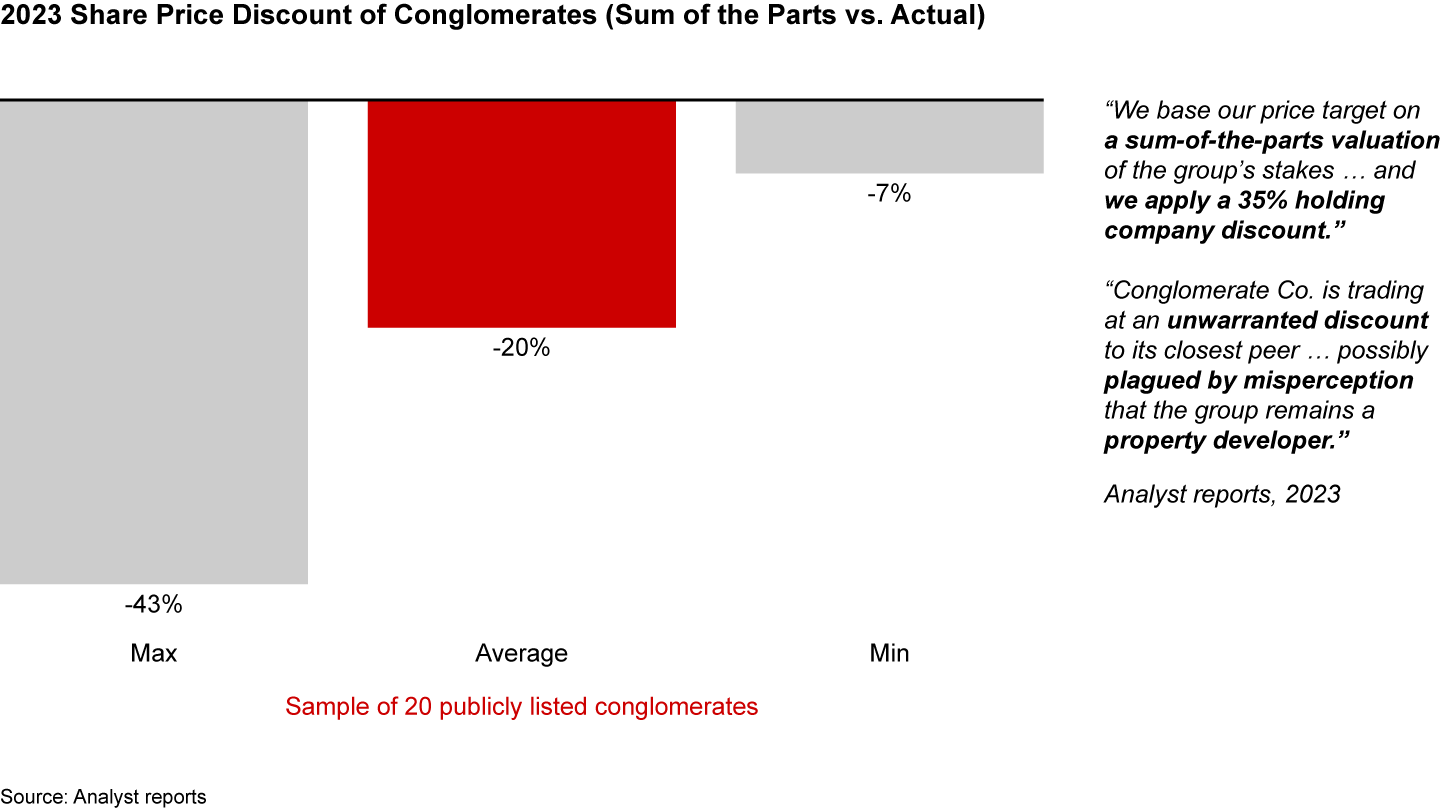

For example, Keppel Corporation privatized two of its listed business units, making them fully owned subsidiaries of the listed holding company. Sime Darby took a different approach; it spun out Sime Darby Plantations and Sime Darby Properties into separate entities, leaving behind a much smaller conglomerate and creating substantial shareholder value in the process. In the Philippines, Metro Pacific Investments Corporation just announced plans to privatize one of its holdings to escape the conglomerate discount and provide a better structure to nurture new growth pillars. “How can you raise equity money at a very low share price?” asked Manuel Pangilinan, Metro Pacific’s chairman and president.
Ultimately, two distinct structures for conglomerates are likely to dominate the market:
- Type A: The holding company is listed, and subsidiaries are fully owned by the holding company.
- Type B: The holding company is privately owned, with subsidiaries either partially listed or fully privately owned.
Type A is the best model for conglomerates with cohesive portfolios and a center that actively drives value across a related set of businesses. This structure allows financial and human capital to be flexibly allocated to achieve the greatest returns.
Type B is suited for diversified sets of businesses that operate quite independently and where the center’s value-add is focused on buy/hold/sell decisions and key appointments. This may be a viable long-term structure for family holdings since it allows them to move beyond the founding generation’s entrepreneurial skills. It also supports diversification, which is required to attract returns over multiple generations.
Conclusion
Conglomerates need to take urgent actions to stop the downward spiral.
They need to pursue commercial excellence to create top-line growth and institute operational efficiencies to improve bottom-line performance. Fortunately, technology can help conglomerates lower costs and increase value, even in challenging circumstances. Operational excellence and emerging technologies can protect conglomerates through future economic cycles.
Conglomerates also need to organize for growth and long-term success. Follow market signals to find higher-growth opportunities and future growth engines, and evolve the corporate structure to maximize value. It’s also time to rethink ownership models and capital structures.
Look for disruptive opportunities to transform performance. Conglomerates that defied the odds and thrived through the last decade were fast to respond to challenges and change.
As the leaders demonstrated, decisive moves pay off. Invest in technology. Get lean. Restructure. There’s more than one way to create value over the next decade—but there’s no time to waste.